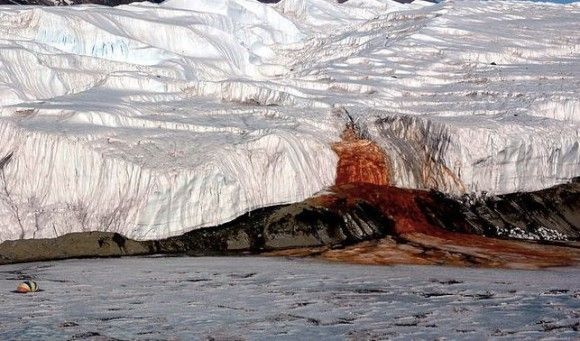Origin of Antarctica’s eerie Blood Falls
 Blood Falls pouring into Lake Bonney. A tent can be seen in the lower left for size comparison. Photo from the United States Antarctic Program Photo Library.
Blood Falls pouring into Lake Bonney. A tent can be seen in the lower left for size comparison. Photo from the United States Antarctic Program Photo Library.
Origin of Antarctica’s eerie Blood Falls
May 18, 2015
by Deborah Byrd in Blogs » Earth, Science Wire
Blood Falls is a bright red waterfall oozing from Antarctica’s ice. It’s nearly five stories high, in the McMurdo Dry Valley region, one of the coldest and most inhospitable places on Earth, a place scientists like to compare to the cold, dry deserts of Mars. Geomicrobiologist Jill Mikucki, now at the University of Tennessee, Knoxville, published what’s still accepted as the best explanation for Blood Falls in 2009. The tests of her team showed that Blood Falls’ waters contained almost no oxygen and hosted a community of at least 17 different types of microorganisms, thought to be flowing from a lake trapped beneath the ice for some 2 million years. Now Mikucki’s work in this area confirms zones of liquid briny water hundreds of meters below Blood Falls. This groundwater network appears to harbor a hidden ecosystem of microbial life, prompting scientists to wonder whether a similar ecosystem could exist on Mars.
Mikucki and her team published their new study in Nature Communications on April 28, 2015. ...
Researchers suggested in the past that a deep salty groundwater system might lie beneath the Dry Valleys, known for decades to have its own permafrost and above-ground network of small frozen lakes. Mikucki and her colleagues partnered with SkyTEM, a Denmark-based airborne geophysical survey company. They used a helicopter to fly a giant transmitter loop over the Dry Valleys. The loop induced an electrical current in the ground. Then the scientists measured the resistance to the current as far as 350 meters (over 1,000 feet) below the surface.
The video clip below shows the sensor flying over Lake Bonney in the McMurdo Dry Valleys, Antarctica.
More info & more pix
http://earthsky.org/earth/blood-falls-five-stories-high-seeps-from-an-antarctic-glacier?utm_source=EarthSky+News&utm_campaign=6699228d97-EarthSky_News&utm_medium=email&utm_term=0_c643945d79-6699228d97-393525109
